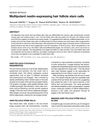TLDR Stem cells in hair follicles can become neurons and other cells, especially in the upper part, useful for nerve repair.
The study found that multipotent nestin-expressing stem cells were present throughout the vibrissa hair follicle in mice, with the upper part showing the highest potential for differentiation into neurons and other cell types. These stem cells were CD34-positive and keratin 15-negative, and cells from the upper follicle formed spheres in culture that differentiated into various cell types, including neurons. The research suggested that the upper follicle could be a valuable source of stem cells for nerve and spinal cord repair, indicating potential applications in regenerative medicine. The study was supported by Japanese grants, with no conflicts of interest reported.
 330 citations
,
December 2009 in “Cell stem cell”
330 citations
,
December 2009 in “Cell stem cell” SKPs are similar to adult skin stem cells and could help in skin repair and hair growth.
121 citations
,
June 2009 in “Journal of Cellular Biochemistry” Human hair follicle stem cells can safely and effectively help nerve regeneration.
 37 citations
,
January 2009 in “The Journal of Dermatology”
37 citations
,
January 2009 in “The Journal of Dermatology” Hair follicle stem cells can turn into various cell types and help repair nerves.
144 citations
,
June 2008 in “Cell Cycle” Hair follicle stem cells can help repair spinal cord injuries and improve walking.
80 citations
,
September 2007 in “Cell Cycle” Stem cells in hair follicles can become various cell types, including neurons.
344 citations
,
June 2006 in “American Journal Of Pathology” 319 citations
,
November 2005 in “Proceedings of the National Academy of Sciences” Hair follicle stem cells can help repair damaged nerves.
419 citations
,
March 2005 in “Proceedings of the National Academy of Sciences” Hair-follicle stem cells can become neurons.
352 citations
,
August 2003 in “Proceedings of the National Academy of Sciences” Nestin is found in hair follicle progenitor cells, linking them to neural stem cells.
6 citations
,
March 2011 in “European Journal of Dermatology” Nestin-positive cells are important for hair follicle regeneration in alopecia areata.

